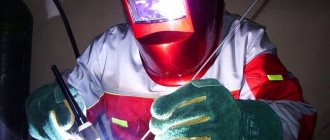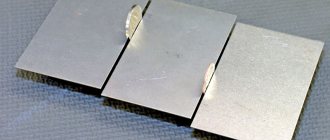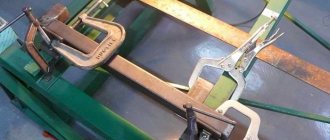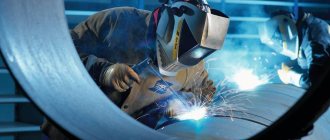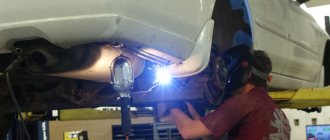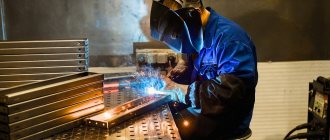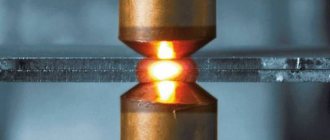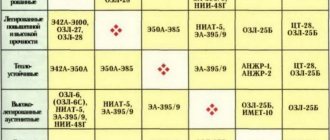Inverter welding power source
,
IIST
,
A welding inverter
is one type of power source for a welding arc.
The main purpose of all welding sources is to ensure stable combustion of the welding arc and its easy ignition. One of the most important parameters of the welding process is its resistance to vibrations and interference. There are several types of welding arc power sources - transformers, diesel or gasoline electric generators, rectifiers and inverters. The inverter welding current source appeared in the 20th century, and at the beginning of the 21st century it became one of the most popular welding machines for all types of arc welding.
Operating principle of the inverter
As already noted, inverters entered the practice of welding not so long ago, at the end of the twentieth century. The operation of devices of this type is based on the principle of voltage shift. This solution allows you to increase the strength and frequency of the current. It should be noted that the device of the inverter used for the work contains a rather complex circuit, within which the following processes are implemented:
Inverter welding machines
- The alternating current supplied to the inverter is converted to direct current. The change in current parameters occurs in the device, which is assembled using a diode bridge.
- The resulting current is transmitted to the inverter, which plays the role of a high-frequency pulse generator. In the transistor unit, the reverse conversion of direct current to alternating current occurs. But the resulting current has a significantly higher frequency than that coming from the power supply.
- High frequency current is supplied to the transformer. This device reduces the voltage and simultaneously increases the current. Since the transformer, which is used to work with high-frequency currents, has small dimensions, all this affects the overall weight characteristics of the inverter.
- After passing through the transformer, alternating current with new parameters is supplied to the rectifier, where it is again transformed into direct current, which is used for welding.
Welding with an inverter for beginners
It should be noted that inverter devices, unlike transformer-type devices, consume half the amount of energy. In addition, the parameters of the current that comes from the device ensure that the welding arc will have stable ignition and combustion during welding.
Types of inverters on the modern market
Welding inverters on the market today can be divided into two main types.
Household
A device such as a household inverter is designed to perform periodic welding work. These devices are inexpensive, but they can be used from time to time; they are not intended for intensive daily work. Such inverters are optimal if you sometimes need to perform simple and short-term welding work. Most of these devices are made in China.
Professional
Such equipment is intended for daily long-term use; its design is initially designed for active use. The cost of these inverters, naturally, is quite high, but it is adequate to their quality characteristics.
The market also offers semi-professional inverter devices, which, in terms of their technical characteristics and cost, are between household and professional equipment. In addition to the above types, there are universal devices, which are also called combined. Their versatility lies in the fact that they can be used to perform welding using various technologies. Due to its wide functionality, such inverter equipment also falls into the professional category.
Technical parameters of devices
Welding inverters have a number of specific characteristics by which one can judge its technological properties. These include the following parameters:
Welding inverter design
- The type of current that is generated at the output of the rectifier.
- The amount of voltage that is used to supply electricity. Manufacturers produce products that operate on 380 and 220 V. The former are used for professional welding, the latter for work at home.
- Current size, this parameter has a direct impact on the size of the electrode that will be used to perform the weld.
Technical parameters of welding inverter
- Unit power, this parameter provides information about the current and strength that will form the welding arc.
- Open circuit voltage, this parameter shows how quickly the welding arc will be produced.
- The range of electrode sizes that will be used for welding.
- Dimensional and weight characteristics of the inverter welding machine and the size of the welding current at the output. The lower the last indicator, the smaller the device, but accordingly such a device has lower performance characteristics.
Circuit design
Inverter welding current sources can be built according to a variety of schemes, but in practice three prevail:
- Single-ended forward pulse converter with PWM regulation and energy recovery. Such inverters are the simplest, lightest and most compact, but power transistors switch with a current break at a non-zero voltage, which leads to significant switching losses and a high level of electromagnetic interference. The circuit can only be implemented on particularly high-speed power MOSFETs or IGBT transistors, so it became widespread only in the early 2010s. Also, the operation of the circuit requires powerful diodes with extremely short reverse recovery time. The performance of the circuit largely depends on the intensity of transients on the parasitic capacitances and inductances of the components, wires and printed circuit board, which requires careful design and high precision manufacturing. The circuit is used in portable welding machines designed for low power (up to 4 kW). Despite the small number of components, such inverters are quite expensive, with 60-70% of the cost made up of special transistors and diodes. The scheme is common among European and Japanese manufacturers.
- Half-bridge or bridge push-pull converter with PWM control. Switching losses and the level of electromagnetic interference in them are less than that of the previous type, but still quite high. The circuit is more complex and requires a larger number of components, but the power developed by the converter is significantly higher than in single-cycle circuits (up to 10 kW). High-speed MOSFETs or IGBTs with high pulse power dissipation capacity are also required, although less than in a single-ended circuit. The requirements for diodes are also significantly lower than in a single-ended circuit. The performance of the circuit depends, but to a lesser extent than that of single-cycle circuits, on the intensity of transient processes on the parasitic capacitances and inductances of the components, wires and printed circuit board. The flexibility, speed and accuracy of PWM control allows you to control the arc current according to complex laws, which improves the quality of welding. The scheme is popular among American and Korean manufacturers.
- Half-bridge or bridge resonant converter with frequency or phase control. The presence of a specially introduced resonant circuit allows you to form an optimal switching trajectory of transistors at zero voltage or zero current, as well as neutralize the influence of parasitic capacitances and inductances. There are no special requirements for switching speed and transistor power, since switching processes occur passively. This allows such inverters to be built using inexpensive transistors and diodes. Even bipolar transistors are suitable. The power of resonant inverters can reach tens of kilowatts. However, the resonant circuit must have significant energy intensity and, accordingly, large dimensions. Therefore, such devices are quite large and heavy. Due to the undemanding nature of resonant converters regarding the characteristics of transistors, the price of such products can be relatively low. For this reason, most of the welding inverters produced in Russia and China are made using resonant circuitry. Resonant converters are also available for home production. The resonant converter has a relatively narrow range and low control speed, so only relatively simple arc current control laws can be implemented on it.
Pros and cons of inverter welding
Inverter devices show efficiency in the range of 85 - 95%, I must say that this is a high figure among electronic equipment. The circuit used allows you to adjust the level of welding current from several amperes to hundreds, or even thousands.
For example, an inverter of the MMA brand, it is 20 - 220 A. Inverters can operate for a long time. The power supply can be controlled remotely. The undoubted advantages of inverters include their small size and weight characteristics, which allow the device to be moved at the welding site. The design of the devices uses double insulation, ensuring electrical safety.
Technological advantages
The use of inverters allows the use of electrodes of any brand that work with both direct and alternating current. Devices of this type can be used for welding with a non-consumable electrode in a shielding gas environment. In addition, the design of this equipment makes it easy to automate welding processes.
Tungsten electrodes for argon arc welding
Electrodes for resistance welding
Welding can be performed using a short arc, thus reducing energy losses and increasing the quality of the weld; in particular, there is virtually no welding spatter on the surface of the parts being welded. By the way, the use of inverters allows you to produce seams in any spatial configuration.
Microprocessor
Microprocessors are used to control modern welding inverters, and this ensures a stable connection between voltage and current.
Disadvantages of inverters
Inverters are somewhat more difficult to repair than traditional transformer units. If some control elements located on the board fail, repairs can cost about a third of the cost of a new welding inverter.
Inverters, unlike other types of equipment, are very susceptible to dust. That is, such devices must be serviced more often. Operation of an inverter welding machine is also limited by low temperatures. In addition, there are some restrictions on storing the inverter at sub-zero temperatures. This is fraught with the formation of condensation, which can lead to a short circuit on the board.
Flaws
- Until the late 2000s, inverter sources were much more expensive than transformer sources and less reliable. As of the 2010s, the price of inverter devices has dropped significantly and is closer to that of transformers. The reliability of IIST has also increased significantly, especially with the beginning of mass use of IGBT modules.
- Limited load factor, which is associated with significant heating of circuit elements.
- Increased sensitivity to air humidity and condensation falling inside the case.
- High (and often dangerous) level of high-frequency electromagnetic interference generated. This problem is partially solved by the use of so-called improved pulse-width modulation and synchronous rectifiers in the secondary circuits. However, these solutions significantly increase the cost and make the device heavier, so they are used only in professional stationary models. In a number of countries, for example, in Canada, Belgium and the Netherlands, there are restrictions on the use of switching power supplies with “hard” switching of transistors. The earliest types of welding inverters (built on bipolar transistors) used the resonant principle and switching of output transistors at zero current phase, which significantly narrows the spectrum of electromagnetic interference and reduces their spectral power. As of 2015, resonant type welding inverters are still produced in Russia and by some manufacturers in China.
How to choose a 220 V welding machine for home and garden
When selecting welding equipment, the consumer must decide what tasks it will be needed for.
If it is used for repairing body parts, then it should have some parameters, and if it is used for the production of metal structures, then it should have different parameters. But in any case, the devices must meet a number of requirements, in particular, functions such as hot start, anti-sticking and some others must be implemented in a home device. This is how inverters differ from traditional devices.
A fan must be installed in the design of this type of device. In addition, the circuit must be protected from power surges. In principle, a device with such parameters can work both in a home workshop and in industrial production conditions.
Types of welding inverters by functionality
There are a huge number of different welding methods. Enterprises can use laser, diffusion, ultrasonic, thermite, electroslag and any other specialized welding method suitable for certain tasks. But these are all industry standards. For domestic needs, 4 methods are most often used, each of which has its own advantages and disadvantages.
MMA
Manual electric arc welding in the technical documentation for welding inverters is labeled as MMA (Manual Metal Arc). In Soviet-era documents, the abbreviation RDS was used. The welding process takes place using piece electrodes and metal rods with a special coating. This is the simplest and most popular welding method. Accordingly, equipment “tailored” only for this method is relatively inexpensive. Manual MMA arc welding is always provided as the main one in household inverters. Professional machines, of course, are also capable of cooking using consumable electrodes.
Welding inverter Watt MMA 220id
TIG
The technology of arc welding in an inert gas environment (argon arc welding) is abbreviated as TIG (Tungsten Inert Gas). In Soviet-era documentation, this method was labeled as RADS. In this case, the welding process occurs using a non-consumable tungsten electrode. The melting point of tungsten is at the level of 3500 degrees, due to which the TIG welding type makes it possible to work with refractory materials (cast iron, titanium) and metals difficult to heat treat, such as aluminum. When choosing the material with which to work, it is necessary to take into account the color marking of tungsten electrodes used for a particular metal or alloy.
If the electrode melted during MMA arc welding, then in this case the solder is supplied manually. The inert gas, creating a protective cloud, serves to protect the metal from oxidation during the welding process, that is, it only improves the quality of the seam. Most often, argon is used as a shielding gas, which is why this method is called “manual argon arc welding.” But argon is not the only possible gas; nitrogen, helium or various gas mixtures can also be used.
The welding process using TIG technology is more complex and requires experience and good skills. Setting up equipment in this mode will also require more adjustments to the settings, which in itself can also be difficult. Thus, inert gas tungsten arc welding is an operating mode for experienced welders. Beginners should first of all master classic MMA welding.
MIG/MAG
If the characteristics of a welding inverter indicate MIG and MAG welding types, then this almost always means that you have equipment for semi-automatic welding. The creation of this method was based on the idea of using an “endless” electrode, which can significantly increase productivity during welding work.
Thus, semi-automatic equipment does not use replaceable electrodes, but a special melting wire containing magnesium or silicon, the length of which can be almost any. During the welding process, the wire is fed continuously, and the feeding process is controlled by the welder.
- The abbreviation MIG (Metal Inert Gas)
means that the welding process uses an inert gas (argon, helium or mixtures), which protects the metal well from oxidation. Thanks to the use of gas, the heat treatment zone is reduced, making it possible to apply several seams without deforming the metal. - The abbreviation MAG (Metal Active Gas)
means that the welding process does not use passive inert gas, but active carbon dioxide. That is, with this welding method, the gas does not create a protective cushion, but actively interacts with the metal. This method is used for welding low-alloy (brittle) steels. The seam is smooth and thin with a minimum amount of waste.
Operating semi-automatic equipment does not necessarily require a gas supply. Moreover, argon cylinders can be expensive. For gasless welding, you can purchase flux-cored wire (with powder in the core). Flux is a special mixture, its composition close to that of electrode coating. During operation, the powder burns, creating a protective cloud that prevents the oxidation process.
The advantage of semi-automatic welding is that you can independently change 4 main parameters: melting and wire feed speed, seam height, direction of electrode movement. In addition, to work with each material, you can select the wire for the appropriate purpose.
Thus, semi-automatic welding inverters are always equipment for professional use. If you have no work experience, there is no point in purchasing such equipment for home use.
Welding inverter ELAND INMIG-220PLUS
CUT
Plasma welding technology is based on the principle of melting the material with a stream of compressed ionized gas (plasma). That is, in this case, it is not an electric arc that affects the material, but a plasma heated to a very high temperature (from 5,000 to 30,000 degrees).
Plasma machines are more expensive than conventional ones, since to ensure the welding process, two inverters are required at once (in one housing): the main and auxiliary ones. The auxiliary one is necessary for ignition, the main one controls and regulates the work process.
CUT plasma welding technology is often compared to TIG because both use non-consumable electrodes. However, CUT has certain advantages:
- Higher efficiency when welding non-ferrous metals and their alloys.
- Thanks to the higher temperature in the working area, it becomes possible to work with refractory metals (surfacing and spraying) to create heat-resistant and wear-resistant coatings.
- Narrow heat treatment zone (thin beam), making the seam more accurate. The width sometimes does not exceed 2 mm.
- Plasma welding is more economical because it does not require the use of cylinders with oxygen and inert gases. To operate a plasma inverter, a household electrical outlet and distilled water are sufficient to create steam.
The simplest plasma inverters with currents from 10 to 60 A are similar in functionality to inverters with TIG welding technology. Their approximate price ranges from 400 to 1000 rubles.
Devices with a possible current of more than 100 A are capable of melting even very thick material and creating a thin and even seam in one pass. However, their cost almost always exceeds 3,000 rubles.
Plasma cutter Fubag PLASMA 65 T 68 443.2 (with torch)
Inverter classification
Welding inverters can be classified by the size of the welding current. Manufacturers produce three types of devices:
- 100-160 A – low-power;
- 160-200 A - average;
- 200-250 A - powerful.
There is a relationship between the size of the current and the dimensions of the device. When choosing a device for use at home, you should be guided by the tasks that they have to solve.
The weakest devices can be classified as devices of the lowest level; many use them to gain work skills. Devices that are classified as middle class are among the most popular and allow you to perform a wide variety of work, from assembling a fence and manufacturing quite complex metal structures. The most powerful devices are mostly used for production purposes. They are used for working with rolled metal of large thickness.
Electrodes for manual arc welding
Most inverters are designed to work with coated electrodes. But they can also be used to work with welding wire. To do this, a device is installed on the device that feeds the wire into the welding zone. The wire is fed through the welding gun, and the gas mixture is also fed through it, protecting the working area from exposure to atmospheric air.
Links
Electric arc Manual arc · Gas shielded arc
Automatic
submerged arcPressure welding Kuznechnaya · Ultrasonic
·
Friction
·
Gas press
·
Cold
·
Explosion
·
Magnetic pulse
·
Diffusioncontact welding Spot · Embossed
·
Suture
·
Butt
·
ReflowOther types of welding Gas · Electroslag
·
Thermite
·
Plasma
·
Electron beam
·
Laser
·
X-rayEquipment and equipment Welding electrode · Welder suit
·
Welding transformer
·
Welding unit
· Welding inverterOccupational diseases Electroophthalmia · Manganese poisoning
Professional organizations Electric Welding Institute named after. E. O. Paton · Department of Welding, Moscow State Technical University named after N. E. Bauman
·
American Welding Society
Additional functions in inverters
Modern inverter devices implement some options that significantly facilitate the welder’s work:
- Hot start - often novice welders, and not only them, have difficulty igniting and maintaining the arc in working condition. At the moment of ignition, the current rises to the required level and immediately after ignition returns to operating parameters. The process of changing the current occurs completely automatically, without the participation of the welder.
- Another problem that plagues beginners is electrode sticking. There are several reasons for this, but there is only one solution - reducing the level of welding current. This operation is also performed automatically.
- Arc forcing allows you to make seams in different spatial positions.
- Reducing the no-load voltage to a level that is safe for the worker and his surrounding people.
Technical capabilities of inverter devices
Any inverter, being a welding machine, serves to ignite the welding arc and maintain its combustion in a stable state. Due to the features of its design, the inverter device copes with this task perfectly. In addition to the main function, modern inverter models are equipped with a number of additional options that make their use as convenient and comfortable as possible. These include:
- “Hot start” (this option allows you to ignite the welding arc faster, which is achieved by applying an additional electrical pulse to the electrode);
- “Arc force” (this function assumes that when the electrode suddenly approaches the surface of the parts being welded, the welding current automatically increases, which prevents the electrode from sticking in such a situation);
- “Anti-sticking” (this option works as follows: when the electrode sticks, the electric current stops flowing to it; it starts flowing only when the electrode is torn off from the surface of the parts being connected).
Front panel of the welding inverter "BIMark-170"
Some models of inverter devices are also equipped with overheating indicators and an automatic shutdown option if overheating does occur. This useful function protects such an expensive device as an inverter from burning out and, as a result, from costly repairs.
The additional options described above are especially useful for novice welders, as they help minimize the impact of a specialist’s skill level on the quality of welding.
Determining the characteristics
Like any technical equipment, welding inverters have a number of technical parameters that determine their capabilities.
Welding current
Inverter welding machines provide the generation of welding current in the range from 100 to 250 A.
Open circuit voltage
After converting the current supplied from the electrical network to 220 V, a current with a voltage of 50 - 90 V and an operating frequency of 20 - 50 kHz is obtained at the output of the device. Maximum voltage must be used to ignite the arc, but this creates a safety hazard for the welder and surrounding people. Therefore, after finishing work, the voltage drops to a safe level.
Maximum current operating mode
An important indicator of the operation of any welding machine is the operating time. It may be called PN or PV. This indicator indicates how long the device will operate with a ten-minute welding cycle before shutting down.
In other words, if the duty cycle is 50%, this means that the effective operating time will be 5 minutes, if the indicator is 70%, then the time will be 7 minutes. This indicator must be reflected in the technical documentation included in the delivery of the welding machine.
How to properly cook by welding, video instruction
Let’s say you just need a welding machine for housework, but you don’t know how to weld properly. The video material presented below will help you understand this process once and for all.
How to choose a good welding inverter
It consumes relatively a lot, around 5 kWh, and the product description provided by the supplier directly on the sales site shows that it does not come with a plug-in connector. It is already quite clear that only professionals know how and what to choose in the field of welding inverters, and if you count among hobbyists or semi-professional users, you will face great difficulties trying to find out where welding inverters are at a good price or decide which model is the most suitable for you.
But first, a little theory. To begin with, we list the items a worker needs for welding:
- 1. Protective mask.
- 2. Suede mittens.
- 3. Tools for removing slag.
- 4. Welding unit.
- 5. Electrode or special wire.
- 6. Protective suit.
To make a high-quality weld, the first step is to develop practical welding skills. Without a doubt, each subsequent seam you make will be better than the previous one, so it’s best to try your hand at simple surfaces first. An integral part of welding work is safety precautions; under no circumstances start work without gloves and a mask. The metal that you will weld must be thoroughly cleaned with sandpaper or a file, this is necessary so that ignition of the arc does not cause problems and the weld is neat, since dirt and rust interfere with this.
Whether you need to weld pipes, various parts, or work with this technique in metal sculpting, it is imperative to know what type of device is suitable for the task you propose. For everyday and long-term use, a classic welding machine is better, but if you want high mobility, sophisticated technology, low consumption, and you can use a household power source, then an inverter is the best solution. We've put together a short list of features that any quality model should be able to match, and depending on which one you can target to make your desired purchase.
Welding rectifiers
The voltage in 220V home networks will not be enough for the rectifier. For most functions to function correctly, 380V (three-volt industrial power supply) is required. This is a significant drawback of rectifiers. Any welder needs to be able to strike an arc correctly. Rectifiers do not have features such as arc force and hot start, so novice welders may have difficulty using the rectifier right away.
Input voltage
Welding inverters are powered from a standard city (220 V) or three-phase network (380 V). Household appliances can be connected to a regular outlet. Professional ones can be compatible with a three-phase power supply. Sometimes a welding inverter provides both connection options. There are no efficient battery inverters yet.
When choosing, you need to pay attention not only to the type of connection to the electrical network, but also to the sensitivity of the inverter to voltage drops. For urban networks, a deviation of 10-15% in any direction is quite likely, but almost all models are designed for such jumps.
At the same time, if the inverter is supposed to be connected to an autonomous generator or voltage surges in the network are possible within 20-30%, it is necessary to select equipment with protection against surges. This model will cost a little more, but there will be no additional problems during operation.
Welding transformer: device and principle of operation
A classic transformer consists of:
- The primary winding is made of insulated wires that receive electricity from the network.
- Secondary non-insulated winding.
- Core (closed magnetic circuit).
- Suspension system for transformer elements.
- A control system that controls the location of the windings and the size of the air gap between them.
- Air gap control screw.
- Propeller control handle.
The transformer core directly transforms the voltage from the network to the desired level. When a device is connected to the network, electricity first flows to the primary winding, where a magnetic field is created by specifically placed turns. Further, taking into account dissipation, the field is transmitted to the secondary winding, with turns, the number of which differs. The distance between the windings determines the voltage level: the further they are located, the lower it is. Since the secondary winding ends at one end of the electrical holder, the required voltage is supplied there.
Welding rectifiers
The operating principle of rectifiers is simple. First, the device reduces the 380V network voltage to no-load voltage, then converts alternating current to direct current. Controlled welding current can be used during welding work. The main difference between a rectifier and a transformer is that the former uses direct current to create a weld, while the transformer uses alternating current. In other aspects, both types of welding equipment can be called similar. Some welders even claim that a rectifier is the same as a transformer, only simpler to use. The advantage of the rectifier is the ability to operate in any conditions. The same inverter is not designed to work in dirt and dust, and for a rectifier such circumstances do not matter. It is also great for difficult welding jobs such as welding stainless steel or non-ferrous metals. In skillful hands, the arc burns stably, which makes it possible to make even and neat connections. Most welding technologies can be used with rectifiers: MMA, TIG, MIG or MAG. Another plus is the ability, using only one rectifier, to create several welding stations, which will allow several specialists to work simultaneously. However, rectifiers have three significant disadvantages:
- Heavy weight. This often prevents you from moving the equipment yourself.
- High cost of additional elements. The rectifier itself does not cost very much, but a complete set of all the necessary equipment can cost a considerable amount. You also need to prepare for high energy costs.
- The need for a certain dexterity of the employee. Beginners will not be very comfortable working with such a device, but after constant practice with a rectifier, a novice specialist will be able to master any welding equipment.
The best choice for home use. Most often, they are also equipped with functions for recharging the car battery. Sometimes the kit includes devices for feeding wire, which is required for MIG/MAG welding (semi-automatic). Such welding devices do not require a lot of electricity. They are very practical. Such devices usually have three operating modes:
- Charging batteries. Voltage 12 or 24 V.
- Starting a car engine. The maximum starting current is 250 A for 12 V and 200 A for 24 V.
- Welding. The current is adjustable from 30 to 180 A, the intermittency coefficient of modern welders is measured as a percentage. That is, a coefficient of 60% means that the arc will burn continuously for 6 out of 10 minutes.
Most welding equipment has overload protection and digital ammeters.
Insulation class
The insulation class regulates the degree of resistance of insulating materials to possible heating. In modern welding inverters, depending on the model, one of the following options may be provided.
- A (105C°)
- E (120C°)
- B (130C°)
- F (155C°)
- H (180C°)
The most commonly used insulation classes are B, F, H. It is worth noting that almost every welding inverter has electronic protection that turns off the device before the insulation can overheat. Thus, high-temperature-resistant insulation is rather an additional guarantee that the wiring will not catch fire in the event of a short circuit.
Welding inverter ELAND ARC FORCE-205 PRO NEW
